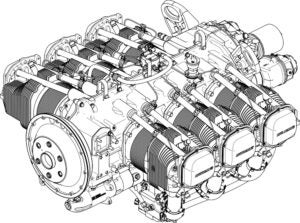I’ve begun doing some preliminary research on the details of engine and firewall forward installations for our Rocket project. “Research,” in this case, means looking through files and forums for pictures of what other folks have done mostly to get an idea of the possibilities, not to copy an entire installation. Copying a specific installation is difficult because of the variation in engine configuration. If you’re new to the world of Lycomings, you might think that “an IO-540 is an IO-540” and you’d be laughed out of the mechanic’s lounge. There is a rumor going around that Lycoming once built two identical engines—but no one has ever been able to prove it. You see, it’s all in the “suffix.”

For example, the engine sitting on a pallet in my hangar that is intended for the Rocket is an IO-540-D4A5. The “IO” says it is a fuel injected horizontally opposed engine. The “540” tells you its displacement in cubic inches, and the “D4A5” is the all-important suffix that tells you how it is configured.
Lycoming publishes a document known as SSP-110-2, titled “Lycoming Certificated Aircraft Engines”. It is the definitive (almost) guide to the various specific models of engines that they build. I say almost because there are many clones of Lycoming engines in the experimental world that might not obey the same rules, but if you are buying a certified engine, this guide will tell you exactly what you’re getting—it just takes a little work. The problem is that the description of each model (by suffix) references other models (by suffix), and the chain can get long and complex. For a specific suffix, you essentially read the book backwards, copying down each variation from model to model until you get back to the “root engine. Let’s look at my engine as an example:
The IO-540-D4A5 is listed as producing 260 hp at 2700 rpm running 100 octane fuel with a compression ratio of 8.50:1 Then we get to the details. It is the same as
- an O-540-E4A5 but with Bendix Fuel Injection, which is the same as
- an O- 540-A4D5 except it is run at a higher speed (providing more horsepower), which is the same as
- an O-540-A1D5 but with more effective counterweights for use with Hartzell “compact” propellers, which is the same as
- an O-540-A1B5 except with retard breaker magnetos, which is the same as
- an O-540-A1A5 except for short prop governor studs and two impulse coupled magnetos, which is the same as
- an O-540-A1A except that it has (1) fifth order and (1) sixth order counterweight
Which brings us to the O-540-A1A (the root engine) that has two sixth order counterweights!
That means that my engine, as it sits on the pallet, with all its certification paperwork, is a 260 HP engine with Bendix fuel injection, with more effective counterweights for the Hartzell compact propellers, and retard breakers. We have no idea if the counterweights are still (1) fifth and (1) sixth order because we don’t know what they did to make them compatible with that Hartzell, but in any case, I’m going to change to an electronic ignition, which will make it Experimental and no longer in the “family” of certified Lycomings. But at least we know what it is… or what it isn’t.














Interesting, but now my head is spinning from the ‘is the same as’ sequence
Working around Lycomings, I have a whiff of how this works, but would have to look up specifics,
but your comment about being laughed out of the mechanic’s lounge is perfect.
Paul it’s still considered to have a 5th order and a 6th order counterweight, as the two orders cover a range of harmonic frequencies if you will.
The change for the more effective counterweights for the compact props changed the masses, but did not change the order. The usage of “5” as the 4th suffix digit indicates that the counterweights are 1 fifth and 1 sixth order. e.g. (I)O-540-()()()5; this is specifically called out in the notes on the type certificate data sheets for the relevant models which are more specific than SSP-110.
Lycoming Service Instruction 1012 provides more detail on the specific crankshaft counterweight (damper) configurations and parts used for specific engine models.